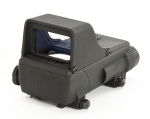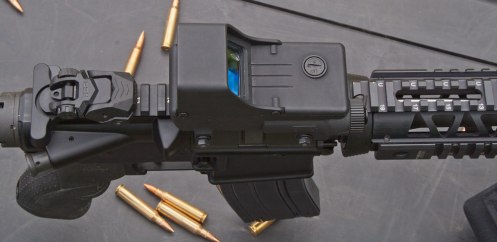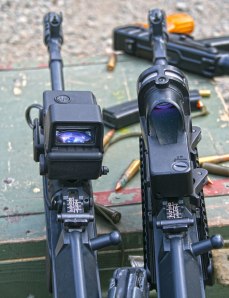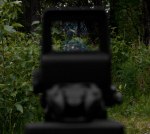Affordability and Military-Grade Durability meet in the Mepro TRU-DOT RDS Sight
So often, shooters are faced with a dilemma when choosing an optic. Do we compromise quality for an affordable price? Or do we forgo buying ammo or other necessities in order to afford a quality optic? We all know that affordability and quality are mutually exclusive when it comes to optics. I have several AR-15 carbines. I have a couple AKs, a couple vz.58s, and an assortment of other firearms. My kids have ARs, and so does my wife. If I am spending around $600 apiece for quality reflex optics, I will find myself penniless straightaway. On the other hand, I would rather use iron sights than most of the inexpensive knock-off optics.
So I was very enthusiastic when Meprolight and their US importer, The Mako Group, announced the M5 sight a few years back. The retail price was projected to be under $400. I had the opportunity to shoot one of the first versions of the M5, and I was even more excited. Here, finally, was a high-quality, MIL-SPEC red dot sight that was going to be affordable. But the expected release date was pushed out again and again as the IDF requested changes to the sight. At the beginning of this year, the final version of the M5 was announced with a retail price over $600. While the price was in line with the quality of the sight (I was able to play with one) I was still disappointed. The too-good-to-be-true price had failed to materialize, after several years of waiting. I really liked the M5 sight, but I had really been looking forward to a lower price. 
I was not the only one disappointed that the IDF’s requirements had increased the cost of the M5. I heard rumblings of discontent throughout the firearms community. Apparently, Meprolight heard, too, because they recently announced that they are making a version of the M5 designed specifically for the US law enforcement market.  Marketed as the TRU-DOT RDS, this new sight borrows from some of the cost-saving features of the earlier M5 models, while retaining many features of the current M5. As I understand it, these changes, combined with juggling margins, and selling only directly to dealers and retail customers, not to distributors, allowed Meprolight and Mako to offer the TRU-DOT RDS at an MSRP of $399. As far as I know, this is a first for a modern military optic.
Marketed as the TRU-DOT RDS, this new sight borrows from some of the cost-saving features of the earlier M5 models, while retaining many features of the current M5. As I understand it, these changes, combined with juggling margins, and selling only directly to dealers and retail customers, not to distributors, allowed Meprolight and Mako to offer the TRU-DOT RDS at an MSRP of $399. As far as I know, this is a first for a modern military optic.
So once again, I was thrilled with the idea of this optic, but I wanted to be sure I was thrilled with the optic itself. I recently received a pre-release model and have been testing it. I wanted to see if quality had been compromised to reach the price. I have to say that the sight was all I had hoped it would be.

Mepro TRU-DOT RDS mounted on a Colt LE Carbine.
Overview
The Mepro TRU-DOT RDS is a reflex-style sight. Unlike previous Mepro optics, the aperture lenses are placed to the rear of the sight, rather than the front, reminiscent of an EOTech sight. The sight utilizes a stronger lens system, actually using a prism, and the reticle is a 1.8 MOA red dot. The body of the sight is made from aluminum, and the hood over the lens system is made from aluminum on this sight, and will be on the first 1,000 sights. After the initial 1,000 sights, the hood will be made from polymer. While I have not bee noble to evaluate the polymer hood, I have evaluated the original version of the M5 with it’s polymer hood, and had no worries about the construction of that hood. Since the polymer hood is being redesigned and improved for the TRU-DOT RDS, I am confident that it will work great and might save a little bit of weight as well. The mount is a built-in quick release mount for Picatinny rails. The tension is adjustable, for rails that are out of spec. The sight is powered by a single AA battery that is installed from the front right side of the sight. The power switch is a rotating switch on the left side of the sight. There are no their controls on the sight, except for the zero adjustments, which are flush-mounted dials that can be turned with a cartridge case rim. Overall the sight is nicely finished with a black anodizing.
Lens and Reticle

Reticle at full brightness. Photos are poor and show a reflection from the camera lens. I could not capture the sharpness of the reticle.
The lens is extremely clear and bright. It is rectangular and the dimensions are 33mm wide by 22mm tall. A true parallax free 1x sight, the TRU-DOT RDS has an unlimited field of view when used with both eyes open.
There is not tint to the lens, nor any darkening of the target area when viewed through the sight. When my 6-year-old first used the TRU-DOT RDS, she said, “OOOOH! This is NICE! And it doesn’t pinken everything! You can see through it all clear.”
The sight is completely free of distortion from side to side, top to bottom, and corner to corner.
The reticle is a traditional red dot. The 1.8 MOA size is ideal for precision, while still bright and large enough to use quickly for CQB.
There are four brightness settings. The switch is marked 0, 1, 2, 3, 4. 0 is the off position. 1 is the brightest setting, with 2 and 3 at decreasing brightness levels. 4 is the night vision setting. The switch is designed so that the first position from the off position is the brightest.
The simplicity of the controls is a departure from most modern optics. Most manufacturers tend to make sights more complicated in order to impress potential customers with their features. It seems that Meprolight chose instead to ask which features were actually necessary and to make this sight as simple as possible.
The three daylight settings and one night vision setting cover any lighting condition a soldier might face. The single switch, located to the side of the sight to clear backup sights or magnifiers, is simple and foolproof.
Battery Compartment

The battery compartment is offset to the right, allowing batteries to be replaced even with other accessories mounted in front of the sight.
The battery compartment holds a single AA battery for 15,000 hours of battery life at the highest power setting. The batty compartment is located on the front of the sight, offset to the right. This makes battery changes easy with the sight mounted on the rifle, even if there is other equipment mounted behind or in front of the sight.
The long battery life, with the auto-shutdown feature, means that the sight could be left on and the battery could, theoretically, last a lifetime. Batteries can fail for many reasons, not just from discharging, though, so I still recommend periodically replacing the battery.
If the battery becomes low, the reticle will begin blinking, indicating a battery change is necessary. Due to the long battery life, I have no practical way to actually test and confirm the battery life.
Zero Adjustments
The sight is zeroed using adjustment dials on the top and left side of the optic, toward the front. The dials are flush and can be turned with a cartridge case rim, coin, or screwdriver. The adjustments are positive and the dials will not move on their own, especially since they are built flush for protection.
Each click makes a .4 cm adjustment at 25m. This translates to a 1.6 cm adjustment at 100m, or .6 inches at 100 meters. The manual includes detailed zero instructions, a zero target diagram, and a trajectory diagram for a 50m/250m carbine zero, showing points of impact for 25m, 50m, 150m, 250m, and 300m.
Sight Controls
All controls are accomplished using a single, simple, five-position dial switch, as described above. The switch is designed to be easy to manipulate, while protected from being inadvertently rotated by its shape, position, and positive detent that holds it in each position.
The switch is circular, but it rotates only down through the positions and back up to off – it does not spin completely around. The switch move only about 45º. I personally liked the elongated teardrop shape of the original M5 sight, but it is clear why the change was made to a round switch, since the round switch will not be moved by bumping something or rubbing against gear.

Mount
The mount is a throw-lever quick-detach mount. The levers are on the right side of the sight, and are built to be below-flush with the side of the optic. This streamlines the optic and prevents the levers from being inadvertently grabbed when charging the weapon.
On the right side of the mount are two self-locking adjustment nuts. This allows the user to fine-tune the pressure of the QD mount. Many rails are out of spec, and the user can adjust the mount to the individual rail. For police departments that want a permanent mount, the nuts can be tightened completely, disabling the quick-detach feature and making a permanent mount.
Specs

Testing the Mepro TRU-DOT RDS on a CzechPoint Sa vz.58
Eye Relief: Unlimited
Field of View: Unlimited
Magnification: True 1X
Window Dimensions: 33mm x 22mm
Reticle Size: 1.8 MOA
Length: 4.3 inches
Height: 2.55 inches
Width: 2.1 inches
Weight: 9.5 oz.
Waterproof Depth: 20 Meters
Operating Temp Range: -40º to 140ºF
Storage Temp Range: -40º to 160ºF
Power: 1 AA Battery
Meets MIL-STD-810G
Testing the Mepro TRU-DOT RDS
I mounted and tested the Mepro TRU-DOT RDS on a number of different firearms.
Of course, I tested it on flat-top ARs, chambered in 5.56, .22 LR, and 6.8 SPC. On the AR-15, the TRU-DOT RDS is a very comfortable optic to use. It aligns perfectly with the eye, and is as quick and instinctive as any quality reflex sight. Cowitness is lower-third, which I prefer, but the iron sights are a little higher in the window than in most lower-third co-witness optics, and I found it worked very well for me.
On a flat-top receiver rail, the TRU-DOT RDS can be mounted well forward, leaving plenty of space behind it for backup sights, a grenade launcher sight, or a magnifier. Since there are no controls on the back of the sight, nothing mounted behind the optic will interfere with operation. The offset battery compartment prevents most things mounted forward of the sight from interfering with battery replacement.
The light weight of the sight is nice, especially when my kids were using it on a Smith & Wesson M&P 15-22. It is a shame to take that very light rifle and add a heavy optic, so this is an ideal sight for such a rifle.
The 1.8 MOA dot reticle is crisp and clean and small enough for precise shooting, as far as red dot sights go. I found that the brightest setting was too bright for all but the brightest outdoor conditions, which is exactly as it should be. The second setting works well in most outdoor daylight conditions, and indoors as well. The third setting is perfect for shooting in dusk-to-dark conditions, and of course, the night vision setting is unusable with the naked eye, but correct for night vision devices.
The sight is advertised as having an unlimited field of view, and this is the case, as it is used with both eyes open and focused on the target. The sight does not limit the field of view, except for the amount that the rifle itself blocks anything below the rifle from view.
All optical sights will display parallax, but quality reflex sights are generally considered parallax free. This is because the parallax is managed in such a way that it does not prevent accurate shooting. With reflex sights, this is generally accomplished by building the sight so that parallax can be seen only at the closest ranges, so there is no parallax at reasonable combat ranges. The TRU-DOT RDS is no exception, and from about 15 meters out, no parallax can be observed. From about 10 meters to 15 meters, only a small amount of parallax is is evident, while it can be readily observed at 10 feet or less. At very close ranges, parallax does not effect accuracy, because even if there were a lot of parallax, the reticle moves a minuscule distance in relation to the relative size of a target at say ten feet. In other words, parallax at 10 feet will have no effect on the accuracy of the sight, but parallax at 200 meters could mean a miss. By moving the parallax in to the closest ranges, the parallax has no effect on the accuracy of the firearm, and from from about 15 meters out to infinity, there is no visible parallax. From my observations, the Mepro TRU-DOT RDS sight is truly a parallax-free sight.
The auto-shutdown feature was something I was very curious to test. Most importantly, I wanted to determine how reliably and how quickly the auto-activation worked. I had recently seen a video advertising another sight that uses and auto-shutdown feature that has an “ambush mode” to keep the sight turned on when the shooter is motionless. In the video, a camera was mounted behind the sight and the rifle put down and allowed to shut down. A shooter then grabbed the rifle, picked it up, and aimed it at a simulated intruder. It was interesting to me that the auto-activation did activate the sight, but by the time the reticle re-illuminated, the rifle was already pointed toward the intruder.
The TRU-DOT RDS does not have an “ambush mode” and I was curious to discover whether this was a feature that should have been incorporated. I can definitely say there is no need for an ambush mode on the TRU-DOT RDS. I cannot hold the rifle still enough to allow the sight to shut down. Even if it did shut down, the slightest movement reactivates it. The auto-reactivation proved to be instant. You will not be able to pick up the rifle and see the sight reactivate. It will reactivate as soon as you move it at all. I was able to see the reactivation by laying the rifle down, allowing the sight to shut down, and then, while looking through the sight, reaching out and grasping the handguard with one hand. The reticle instantly pops on.I tested this until I was confident that I can trust the sight to be on when I need it. Only one time did I pick up the rifle and see no reticle. I had left the switch in night vision mode.

Mepro TRU-DOT RDS and Mepro M21 forward-mounted on Sa vz.58 Rifles
On an Sa vz.58 rifle, the sight was mounted on a railed handguard. There are advantages to mounting a reflex optic forward on a rifle, and this setup worked very well. Again, the light weight of the TRU-DOT RDS is an advantage when mounting the optic in a forward position. This optic look really good on the vz.58, kind of mean-looking and fitting the lines of the rifle.
On a pathfinder KPOS, again the sight is light and compact while still offering the advantages of a full-sized sight.
I really like this sight. I have always liked smaller dot reticles, while I like the design of the non-tube-style sights. The quality of the manufacturing and finish is apparent, and I like the confidence of having a military-grade sight, while I really appreciate paying only a little more for this level of quality than I would have to pay for some of the better Chinese-manufactured red dot sights.
I think the TRU-DOT RDS will be a very good option for law enforcement agencies on tight budgets or for police officers who have to purchase their own patrol rifles out of pocket. Whatever your purpose for a red dot sight, I recommend that you take a close look at the Mepro TRU-DOT RDS. You will be seeing more of them on my rifles.
The Mepro TRU-DOT RDS sight is manufactured by Meprolight in Israel. It is imported to the United States by The Mako Group. The expected arrival date for the TRU-DOT RDS sight is mid-August, 2014. The special edition version of the TRU-DOT RDS is available for pre-order from IDF Holsters http://www.idfholsters.com/ or from 7.62 Precision http://www.7-62precision.com/meprolight-optics-and-night-sights/.
- Optics mounted on the handguards of vz.58 rifles. There are certain advantages to forward-mounting optics.









I have a pair of VZ2008 that I want to setup with RDS. I’m interested in hearing how your VZ58’s compared using the two Mepro sights? Thanks!
LikeLike
Both work great on the vz.58. Between the two, it is simply a matter of preference. I like and use both sights, and I would be comfortable using either for any use, from combat to self-defense to bear defense to shooting on the range. However, I personally prefer the M21 over any other reflex sight. It is SO tough, with no need for batteries or electronics, simple with no switches, always on.
On the other hand, the TRU-DOT RDS is lighter, and many people prefer an electronic sight. Some people have a hangup with the tint on the M21 (which is not an issue in any way) so they like the untinted glass on the RDS. Also the RDS works well in illuminating a small, precise dot.
As far as mounting on a vz.58, there are two ways to do it. The first is mounted forward on the handguard, and the second is mounted over the receiver cover on the CSA short side rail mount, which you can get from CzechPoint. You can also get a railed receiver cover, but I think the side rail mount is a better way to go. Either the forward position or over the receiver works fine, and I prefer a full-sized optic in both locations. There are actually some advantages to a forward-mounted reflex sight. I prefer to use a rail system like the ones you see in the photos, rather than trying to get a low rail and a micro optic to try to get a co-witness with the factory sights. One of the problems that you can run unto is that the low rails get really hot, and will kill the optic over time. The VFR-VZ rail (the aluminum one in the photo) is more stable than any other design, and redirects the gas so it stays cool.
With an optic in this configuration, or on the side rail mount over the receiver, you will want a good stock with a cheekpiece to get the right cheek weld.
LikeLike
Thanks! I’m sure the M21 would work but I like a powered sight (brighter than the tritium powered Mep). This new sight might be what I’m looking for.
LikeLike
Great review! I’m intrigued. Can you offer me any insight into how well this sight will work for someone with astigmatism? Really cheap dot sights look smeared to my eyes. Better ones are cleaner but sadly I have no stores nearby that have Aimpoints, the ‘gold standard’ of dots.
LikeLike
We have had really good feedback on these as far as astigmatism goes.People who have trouble using Aimpoints and EOTechs have reported that they can use this sight.
However, each person tends to have a different effect from astigmatism, so we can’t guarantee how it will work for a particular shooter with astigmatism.
Some find the M21 to be the best sight for use with their astigmatism.
LikeLike
I never knew my astigmatism was the cause for red dots being blurry. I have this sight and it isn’t too blurry, better than many. I have had it on the second brightest setting since I got it (I was one of the first, with the aluminum housing) and the dot just started flashing. So it appears a single battery will last about a year constant on.
LikeLike